八年级英语UnitWhatshouldIdo教案
- 格式:docx
- 大小:56.36 KB
- 文档页数:17
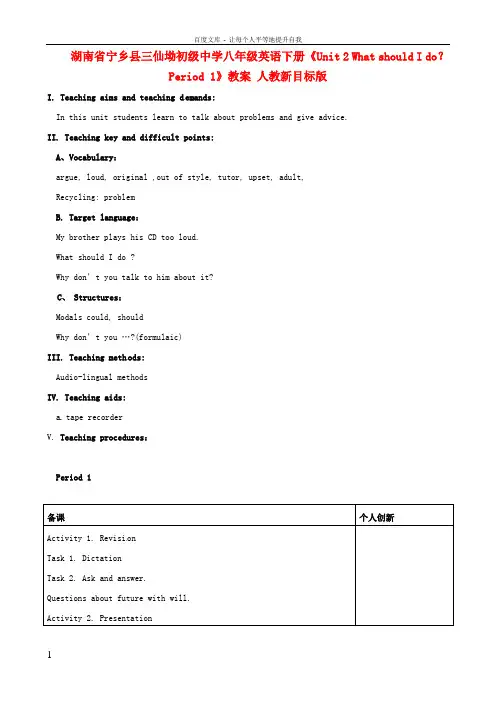
湖南省宁乡县三仙坳初级中学八年级英语下册《Unit 2 What should I do?Period 1》教案人教新目标版I. Teaching aims and teaching d emands:In this unit students learn to talk about problems and give advice.II. Teaching key and difficult points:A、Vocabulary:argue, loud, original ,out of style, tutor, upset, adult,Recycling: problemB. Target language:My brother plays his CD too loud.What should I do ?Why don’t you talk to him about it?C、Structures:Modals could, shouldWhy don’t you …?(formulaic)III. Teaching meth ods:Audio-lingual methodsIV. Teaching aids:a tape recorderV. Teaching procedures:Period 1备课个人创新Activity 1. Revisi onTask 1. DictationTask 2. Ask and answer.Questions about future with will.Activity 2. PresentationThis activity introduces some new vocabulary.Task 1 . Make a two-column chart on the board with the heading Proble m at the top of column 1 and the heading Advice at the top of column 2 .Then ask the students to tell you what you could do about it.Task 2. Then read the problem to the class again. Then write the words could ,should ,and shouldn’t on the board next t o the chart. Read the problem to the class again and help the class give advice using the words could, should ,and shouldn’t.Task 3. Ask the students to finish the task in 1a.Teac h : Serious problem is a very bad problem, a very big problem. Out of style means not in fashion.enough money : I don’t have enough money to buy a bike.Ask the students to write the problems in the serious or Not serious column.Task 4. Talk about the answers.Ask ,Who put “My parents want me to stay at home every night?” the serious column? Ask the same questions about the other items. Discuss whic h problems students thought were the most serious.Activity3. Listen and circle the problems you hear in activity 1a.Task to the pictures in activity 1a. Ask different students to say what they see in each picture. Read the instructions to students.Task 2. Play the recording the first time. Students only listen.Task 3. Play the recording a second time. Students circle the proble ms Problem I want to buy a new guitar but I don’t have enough money. Advice1. Wait until next year.2. Don’t buy a guitar.3. Borrow one.4. Buy a used guitar.5. Get a part-time job.they hear. Then check the answers.Step4. PairworkAsk the students to look at the problems in activity 1a and make conversations.Homework1.Make up your ow n conversations.2. Make ten sentences with could, should and shouldn’t.Blackboard design(板书设计):Teaching rethinking(教学反思):。
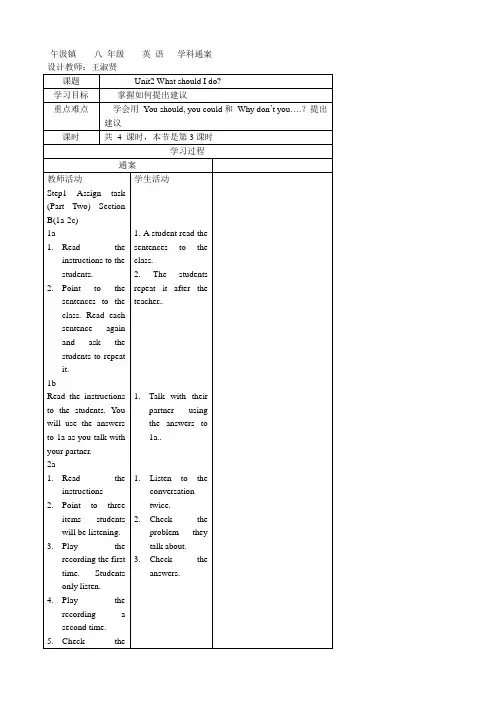
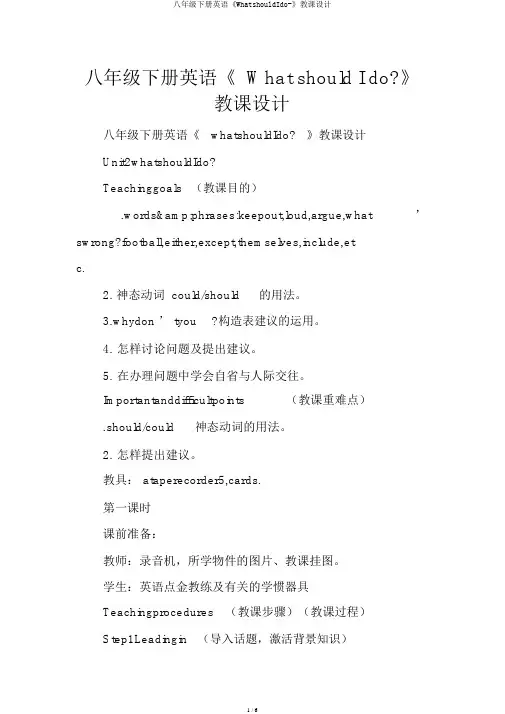
八年级下册英语《 What should I do?》教课设计八年级下册英语《whatshouldIdo?》教课设计Unit2whatshouldIdo?Teachinggoals(教课目的).words&phrases:keepout,loud,argue,what’swrong?football,either,except,themselves,include,etc.2. 神态动词 could/should的用法。
3.whydon ’ tyou ?构造表建议的运用。
4.怎样讨论问题及提出建议。
5.在办理问题中学会自省与人际交往。
Importantanddifficultpoints(教课重难点).should/could神态动词的用法。
2.怎样提出建议。
教具: ataperecorder5,cards.第一课时课前准备:教师:录音机,所学物件的图片、教课挂图。
学生:英语点金教练及有关的学惯器具Teachingprocedures(教课步骤)(教课过程)Step1Leadingin(导入话题,激活背景知识).Greetingsandfreetalk.2.checktheHomework (家庭作业) .Step2Pre-task(任务前活动)T:IwanttobuyanewguitarbutIdon ’thaveenoughmoney.whatshouldIdo?Ssthinkitover,andtrytogivehis/heradvice.writetheiradviceontheBb..Borrowone.2.Buyasecond-handguitar.’ tbuyaguitar.5.waituntilnextyear.PracticereadingtheadvicebytheSs.导入 :Inthisunitwearegoingtotalkaboutproblemspeoplehav eandlearnhowtogivethesepeopleadvice–totellpeoplewhatwethinktheyshoulddo.Step3while-task(任务中活动)SBPage10,1a.theSs.3.AskSstowritetheproblemsinthe“ Serious” or “Notserious” columns.ereading.SBPage10,1b. makesuretheSsunderstandwhatshouldtheydo.Playthetapetime.checktheanswers.Step4Post-task(任务后活动)SBPage10,1c.Lookattheproblemsinactivity1aandmakeconversations.Step5while-task(任务中活动)SBPage11,2a..Readtheinstructions.makesuretheSsunderstandwha tshouldtheydo.2.Pointtothesentencesbelow.toPeter’ sfriend’ sadvice.“ could”or“ should”.5.correcttheanswers.SBPage11,2b.Readtheinstructions.PayattentiontoPeter’sanswers.Playthetapeagain.checktheanswers.Step7Post-task(任务后活动)makeconversationswithpeterandhisfriendwiththehelpof2a&2b.Step8GrammarFocusReviewthegrammarbox.Sssaythequestionsandtheresponses.Explainthedifferencesbetweencould/should.Homework(家庭作业) :.Gooverthewords.2.myclothesareoutofstyle,whatshouldIdo?Pleasegivetheadvice.教课后记 :第二课时课前准备:教师:录音机,所学物件的图片。
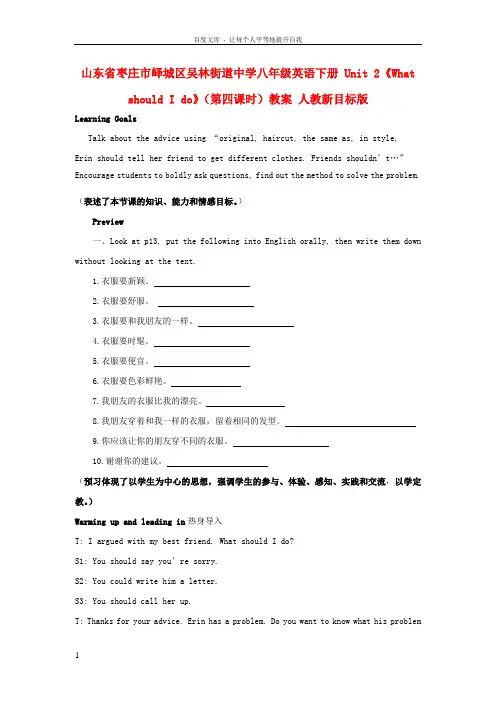
山东省枣庄市峄城区吴林街道中学八年级英语下册 Unit 2《What should I do》(第四课时)教案人教新目标版Learning GoalsTalk about the advice using “original, haircut, the same as, in style,Erin should tell her friend to get different clothes. Friends shouldn’t…” Encourage students to boldly ask questions, find out the method to solve the problem.(表述了本节课的知识、能力和情感目标。
)Preview一、Look at p13, put the following into English orally, then write them down without looking at the text.1.衣服要新颖。
2.衣服要舒服。
3.衣服要和我朋友的一样。
4.衣服要时髦。
5.衣服要便宜。
6.衣服要色彩鲜艳。
7.我朋友的衣服比我的漂亮。
8.我朋友穿着和我一样的衣服,留着相同的发型。
9.你应该让你的朋友穿不同的衣服。
10.谢谢你的建议。
(预习体现了以学生为中心的思想,强调学生的参与、体验、感知、实践和交流,以学定教。
)Warming up and leading in热身导入T: I argued with my best friend.What should I do?S1:You should say you’re sorry.S2: You could write him a letter.S3: You should call her up.T: Thanks for your advice. Erin has a problem. Do you want to know what his problemis?Ss: Yes.T: Let’s co me to 2a.(导入联系所学的内容,使学生自然而然地进入新课的学习。
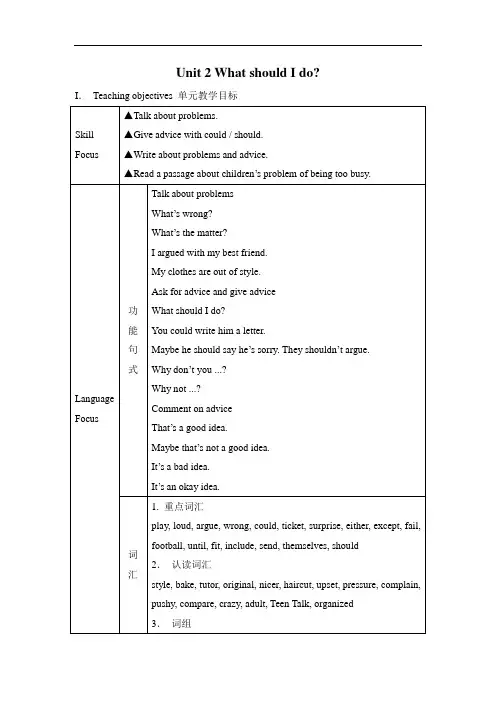
Unit 2 What should I do? I.Teaching objectives 单元教学目标Skill Focus ▲Talk about problems.▲Give advice with could / should.▲Write about problems and advice.▲Read a passage about children’s problem of being too busy.Language Focus 功能句式Talk about problemsWhat’s wrong?What’s the matter?I argued with my best friend.My clothes are out of style.Ask for advice and give adviceWhat should I do?You could write him a letter.Maybe he should say he’s sorry. They shouldn’t argue.Why don’t you ...?Why not ...?Comment on adviceThat’s a good idea.Maybe that’s not a good idea.It’s a bad idea.It’s an okay idea.词汇1. 重点词汇play, loud, argue, wrong, could, ticket, surprise, either, except, fail, football, until, fit, include, send, themselves, should2.认读词汇style, bake, tutor, original, nicer, haircut, upset, pressure, complain, pushy, compare, crazy, adult, Teen Talk, organized3.词组keep out, out of style, call sb. up, on the phone, pay for, the same as, in style, get on, as much as possible, complain about, all kinds of, compare ... with ..., on the one hand, on the other hand语法How to use “should / could / shouldn’t”to give adviceStrategy Focus Listening for specific information CooperatingII. Teaching materials analyzing and rearranging 教材分析和教材重组1. 教材分析本单元的话题是“Problems and advice",通过单元学习,学生不仅能谈论自己生活中的问题,而且能用could 和should来提出建议,并对别人提出的建议进行评价;在掌握功能句式的基础上,要求学生能创造性地应用所学句型,向专栏写信说明自己的问题并寻求建议,另一方面能就别人的问题提出建议,替专栏作者写回复信。
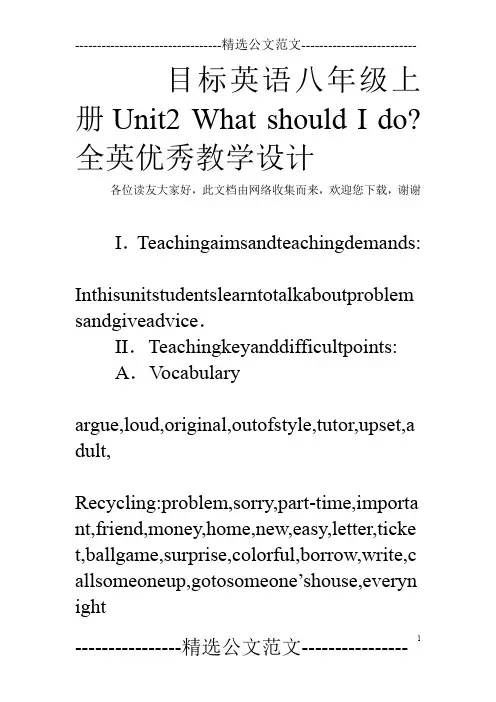
目标英语八年级上册Unit2 What should I do?全英优秀教学设计各位读友大家好,此文档由网络收集而来,欢迎您下载,谢谢I.Teachingaimsandteachingdemands: Inthisunitstudentslearntotalkaboutproblem sandgiveadvice.II.Teachingkeyanddifficultpoints:A.V ocabularyargue,loud,original,outofstyle,tutor,upset,a dult,Recycling:problem,sorry,part-time,importa nt,friend,money,home,new,easy,letter,ticke t,ballgame,surprise,colorful,borrow,write,c allsomeoneup,gotosomeone’shouse,everyn ightB.TargetlanguagemybrotherplayshiscDtooloud.whatshouldIdo?whydon’tyoutalktohimaboutit?c.Structuresmodalscould,shouldwhydon’tyou…? III.Teachingmethods:Audio-lingualmethodsIV.Teachingaids:ataperecorder V.Thisunitisdividedintosevenperiods.Lesson1SpeakandlistenSectionA1a─1cI.Teachingaimsanddemands: Studentslearntotalkaboutproblemsandgivea dvice.II.Teachingkeyanddifficultpoints:A.V ocabularykeepout,play,loud,argue,wrong,what’swron g?outofstyle,could,should,B.TargetlanguagemybrotherplayshiscDstooloud.maybeyoushouldbuysomenewclothes.III.Teachingmethods:Audio-lingualmeth odsIV.Teachingaids:ataperecorderV.TeachingprocedureActivity1.RevisionTask1.DictationTask2.Askandanswer.Questionsaboutfuturewithwill.Activity2.Presentation Thisactivityintroducessomenewvocabulary .Task1.makeatwo-columnchartontheboar dwiththeheadingProblematthetopofcolumn1andtheheadingAdviceatthetopofcolumn2.Thenaskthestudentstotellyouwhatyouco ulddoaboutit.Problem IwanttobuyanewguitarbutIdon’thaveenoug hmoney.Advice1.waituntilnextyear.2.Don’tbuyaguitar.3.Borrowone.4.Buyausedguitar.5.Getapart-timejob.Task2.Thenreadtheproblemtotheclassaga in.Thenwritethewordscould,should,andsh ouldn’tontheboardnexttothechart.Readth eproblemtotheclassagainandhelptheclassgi veadviceusingthewordscould,should,andsh ouldn’t.Task3.Askthestudentstofinishthetaskin1a.Teach:Seriousproblemisaverybadproblem, averybigproblem.outofstylemeansnotinfa shion.enoughmoney:Idon’thaveenoughmoneytob uyabike.Askthestudentstowritetheproblemsintheser iousorNotseriouscolumn.Task4.Talkabouttheanswers.Ask,whoput“myparentswantmetostayatho meeverynight?”theseriouscolumn?Askthes amequestionsabouttheotheritems.Discuss whichproblemsstudentsthoughtwerethemo stserious.Activity3.Listenandcircletheproblemsyo uhearinactivity1a.Task1.Pointtothepicturesinactivity1a.A skdifferentstudentstosaywhattheyseeineachpicture.Readtheinstructionstostudents.Task2.Playtherecordingthefirsttime.Stu dentsonlylisten.Task3.Playtherecordingasecondtime.St udentscircletheproblemstheyhear.Thench ecktheanswers.Activity4.Pairwork Askthestudentstolookattheproblemsinactiv ity1aandmakeconversations.Homework1.makeupyourownconversations.2.maketensentenceswithcould,shouldand shouldn’t.Lesson2ListenandspeakSectionA2a─GrammarFocusI.Teachingaimsanddemands: Studentslearntotalkaboutproblemsandgiveadvice.II.Teachingkeyanddifficultpoints:A.V ocabularycallsb.up,ticket,surprise,onthephone,wha t’sthematter?B.Targetlanguageyoucouldgotohishouse.youcouldgivehimatickettoaballgame.whatshouldI/he/theydo? III.Teachingmethods:Audio-lingualmeth odsandPPPIV.Teachingaids:ataperecorderV.TeachingprocedureActivity1.RevisionTask1.checkthehomework.Askandans wer.Task2.Revisethevocabulary.Activity2.Listeningandcircling.Task1.Readtheinstructions.Learntheke yvocabulary.Readandrepeatthephrases.Task2.youwillhearaconversationbetween Nariandafriend.Playtherecordingtwiceandstudentscirclethe word,Na ri’sfriendusestogiveadvice.Thenchecktheanswers.Activity3.ListeningTask1.Readtheinstructions.Showstuden tstheexamplematch.Task2.Playtherecordingagainandcheckth eanswers.Activity4.GroupworkTask1.Readtheinstructionsfortheactivity.Task2.Pointtotheexampleinthesampledialogue.Asktwostudentstoreadtheconversati ontoclass.Task3.Askstudentstoroleplayaconversati onbetweenNariandhisfriendusingthesetwos etsofsentences.Thenhavethestudentswork inpairs.Task4.checktheanswersbycallingondiffer entpairstosayaconversationtotheclass.Activity5.GrammarFocusReviewthegrammarbox.askthestudentsto saythequestionsandtheresponses.Explaint hatthewordshouldisalwaysusedtoaskforadv ice,butthewordscould,should,andshouldn’t areusedtogiveadvice.couldisalessserious wordthanshould.Payattentiontothequestionsandanswers,ask andanswerloudly.Homework1.Reviewtheconversationandthevocabula ry.2.writeyourownconversationsongivingad vice.Lesson3ReadingandwritingI.Teachingaimsanddemands: Studentslearntotalkaboutproblemsandgivea dvice.II.Teachingkeyanddifficultpoints:A.V ocabularypayfor,part-timejob,okay,either,bake,TeenT alk,tutor,need,maybe,goodidea,badidea,ok ayideaB.TargetlanguagewhatshouldIdo? ThenIthinkyoushouldgetapart-timejob.III.Teachingmethods:Audio-lingualmeth odsandcontrol-readingandwriting.IV.Teachingaids:apictureV.TeachingprocedureActivity1.RevisionTask1.Revisethevocabularyandthekeystr uctures.Task2.Dictation.Activity2.ReadingandwritingTask1.Readtheinstructions.writethepos sibleresponsesontheBbandaskastudenttorea dtheresponsestotheclass.Discussthethreer esponsesandbesurestudentsunderstandhowt heresponsesareused.Task2.Askfourstudentstoreadtheconversa tiontotheclass.Askthestudentstofillintheblank.Thenaskandansweringroups.Activity3.PairworkTask1.Readtheinstructions.Andthenask twostudentstoreadthesampleconversationn .Task2.Askthestudentstosaysomewaystog etmoneythataren’tinthebook.Task3.askthestudentstoworkwithpartners astheyaskforandgiveadvice.Thenasktwoo rthreepairsofthestudentstosaytheirconversa tionstotheclass.Activity4.PairworkThisactivityprovidesanopportunityforstude ntstousethelanguageoftheunittogiveadvice .Task1.Readtheinstructions.Thenasktwo studentstoreadthedialogue.Task2.Askanotherpairofstudentstogivetheiradviceonanothertopic.Pickatopicofcurrentinterestinthenews.Homework 1.Reviewthevocabularyandtargetlanguag e.2.writeyourownconversationsaboutprobl emsandadvice.Lesson4SectionBI.Teachingaimsanddemands: Studentspracticeusingthetargetlanguage.II.Teachingkeyanddifficultpoints:A.V ocabularyoriginal,thesameas,instyle,nicer,haircut,ine xpensive,comfortableB.Targetlanguage IthinkErinshouldtellherfriendtogetdifferent clothes.Friendsshoul dn’twearthesameclothes.Theyarethesameasmyfriend’sclothes.III.Teachingmethods:Audio-lingualmeth odsIV.Teachingaids:ataperecorderV.TeachingprocedureActivity1.Revision Thisactivityintroducesthekeyvocabulary.Task1.Readtheinstructionsin1a.Askastu denttoreadthesentencestotheclass.Readea chsentenceagainandasktheSstorepeatit.T henexplainintheirownwordsthateachsenten cemeans.Forexample:T:whatdoesoriginalmean?S1:Differentfromothers.Notthesame.T:correct.whensomethingisoriginal,itisnotlikealltheothers.canyougiveanexample?S1:mywatchdoesn’thavenumbersonit.Ith aspicturesoffacesinsteadofnumbers.myw atchisoriginal.T:correct.It’snotlikealltheothers.Task2.Pointoutthewrite-inlineinfrontofea chsentence.writeVIifthestatementisveryi mportanttoyou,writeIifthestatementissome whatimportanttoyou,andwriteNIifitisnotim portant.Task3.Talkabouttheanswerswiththeclass.Activity2.ListeningTask1.Readtheinstructions.Pointtothethreeitemsstudentswillbelistenin gfor: Sayyouwillbelisteningtoaradioadviceprogr am.Peoplecallinforhelpwithaproblemandotherpeoplecallupwithadvice.Theywillbe talkingaboutoneoftheseproblems.Pleasec hechtheproblemtheytalkabout.Task2.Playtherecordingthefirsttime.Stu dentsonlylisten.Task3.Playtherecordingasecondtime.A skthestudentstoputacheckinfrontofthesepro blems.Thenchecktheanswer.Activity3.ListeningandwritingA.Listencarefullyandfillinthechartwithth eadvicethatyouhear.Thenchecktheanswer s.B.Listenagainandfillinthechart.Thench ecktheanswers.Activity4.PairworkTask1.Readtheinstructions.Task2.Asktwostudentstoreadtheconversationtotheclass.Task3.workwiththepartnersandsaywhatd oyouthinkErinshoulddo.Asksomepairsofstudentstosaypartoftheirco nversationtotheclass.Homework1.Reviewthevocabulary.2.writeyourownconversationsaboutadvic e.Lesson5ReadingandwritingI.Teachingaimsanddemands: Studentspracticethetargetlanguagebyreadin gandwriting.II.Teachingkeyanddifficultpoints:A.V ocabularyexcept,upset,findout,dowrong,whattodo,lo nely,argueB.TargetlanguagewhatshouldIdo?youcouldbemorefriendly.youshouldtrytobefunny.Everyoneelseinmyclasswasinvitedexceptm e.I’mveryupsetanddon’tknowwhattodo.Ijustfoundoutthatmyfriendswereplanninga birthda ypartyformybestfriend,…III.Teachingmethods:Audio-lingualmeth odsandcontrol-writing.IV.Teachingaids:ataperecorderV.TeachingprocedureStep1.RevisionTask1.checkthehomework.Askandans wer.Task2.Revisethevocabulary.Step2.ReadingandwritingTask1.Teachthesewords:except:Everyonehasabikeexceptjim.Everyonehasabikebesidesjim.findout:learn,Pleasefindoutwheretheylive.Ican’tthinkwhatIdidwrong.Idon’tknowwhattodo.Task2.Askthestudentstoreadtheinstructio ns.Task3.Askthestudentstoreadtheletterandu nderlinetheproblemontheirown.correcttheanswers.Step3.writingTask1.Readtheinstructions.Askastudenttosaysomeoftheadvicetheymig htgive.writethekeywordsontheboard.Task2.Askthestudentstowritethelettersontheirown.Task3.Asksomestudentstoreadtheirletters totheclass.Step4.writingonyourown.1.readtheinstructions.2.askthestudentstosaysomeproblemsthey mightwriteabout.3.asksomestudentstoreadtheirletters.Step5.Groupwork 1.Askthestudentstoreadtheinstructions.2.Asktwostudentstoreadthedialogue.3.Askanotherpairofstudentstogivetheirad viceforoneoftheproblems.4.Askstudentstocompletetheworkingroup s.5.Askafewstudentstosharethesampleconversations.Step6.Selfcheck 1.Askthestudentstodotheexercisesontheir own.Thenchecktheanswers.2.Readtheletterandthenwritesomeadvice.3.Askafewstudentstoreadtheirlettersofad vice.4.justforfun.Asktwostudentstoreadthec onversationtotheclass.Homework1.Reviewthevocabulary.2.Finishoffthewritingexercises.Lesson6ReadingandwritingI.Teachingaimsanddemands: Studentslearntomasterthereadingskills.II.Teachingkeyanddifficultpoints:A.V ocabularyuntil,fit,asmuchaspossible,pressure,compla in,include,pushy,send,allkindsof,compare,c razy,adult,on theonehand,…organized,onth eotherhand,…B.Targetlanguagewhatshouldyoudotorelax? Parentsshouldlearntogivetheirkidsabitmore timetothemselves.III.Teachingmethods:Audio-lingualmeth odsandcontrol-readingandwriting.IV.Teachingaids:atape-playerV.TeachingprocedureActivity1.RevisionTask1.Revisethevocabularyandthekeystr uctures.Task2.Dictation.Activity2.BeforeyouReadTask1.Readtheinstructions.1.Encouragethestudentstothinkaboutlifeo utsideschoolhours.ListthemontheBb.2.AskthestudentstousethelistontheBbtoco mpletethetwoboxeslabeled“Ido”,and“Idon’tdo”.Theyarefreetoaddanyoreactivitiesth eydo,ordon’tcurrently.3.Askafewstudentstosharewhattheyhave written.Task2.Teachthestudentsaboutusingadicti onary.1.Explainthatadictionarycanhelpstudentsl earnindependently.Theycanlearnnewwor ds,howtopronouncethem,andhowtousethe mcorrectly.2.Letthestudentstolookupthewordsintheb ox.3.Haveabriefmemoryquizonallthewords.4.DiscussthepointsmadeintheReadingStr ategyaboutusingabilingual,learne r’sandele ctronicdictionary.Activity3.whileyouReadingTask1.Askthestudentstoreadandnoticethe wordstheyhavejustlookedupintheirdictiona ries.Readthesentencestotheclass.Task2.Askthestudentstoreadthepassagelo udly.Homework 1.Reviewthevocabularyandtargetlanguag e.2.writeyourownconversationsaboutprobl emsandadvice.Lesson7ReadingandwriteI.Teachingaimsanddemands: Studentslearntomasterthereadingskills.II.Teachingkeyanddifficultpoints:A.V ocabularyuntil,fit,asmuchaspossible,pressure,compla in,include,pushy,send,allkindsof,compare,c razy,adult,ontheonehand,…organized,onth eotherhand,…B.Targetlanguagewhatshouldyoudotorelax? Parentsshouldlearntogivetheirkidsabitmore timetothemselves.III.Teachingmethods:Audio-lingualmeth odsandcontrol-readingandwriting.IV.Teachingaids:atape-playerV.TeachingprocedureActivity1.RevisionTask1.Dictation.Task2.Readthepassagetotheclass.Activity2.AfteryouReadTask1.Readthestatements.Task2.Discusswithyourpartners.Task3.Askeachgrouptoreporttheirideastotheclass.Activity3.writing Askthestudentstowriteasentenceoftheirown usingthewordsfromtheboxinSection1b.Activity4.writingTask1.Readtheinstructions.Task2.Reviewlanguageusedforadvice.T henimagineyouareDrAliceGreen.writeale ttertocathyTaylor.Giveadviceaboutwhats heshoulddowithherchildren.Activity5.Goforit! 1.writePressureontheBb.makeasurvey withtwoquestions:whendoyoufeelunderpressure?whatshouldyoudotorelax? 2.Ifthereissomeoneinyourclasswhohasabi gproblem,makeaplantohelpthem.Homework1.Reviewthevocabulary.2.Finishwritingtheletter.各位读友大家好,此文档由网络收集而来,欢迎您下载,谢谢。
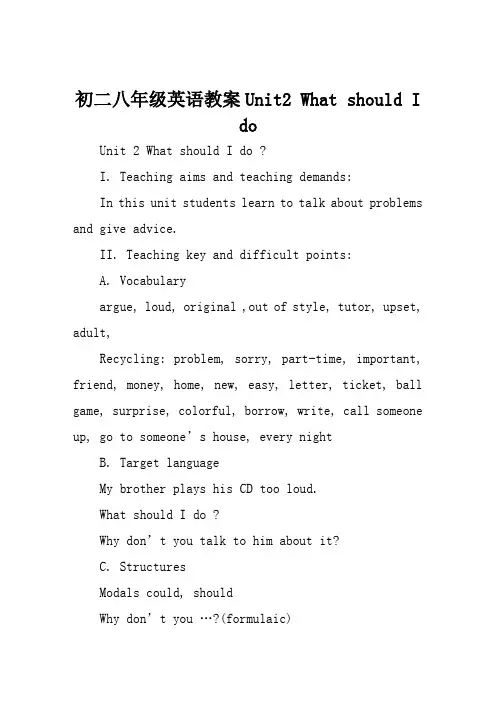
初二八年级英语教案Unit2 What should IdoUnit 2 What should I do ?I. Teaching aims and teaching demands:In this unit students learn to talk about problems and give advice.II. Teaching key and difficult points:A. Vocabularyargue, loud, original ,out of style, tutor, upset, adult,Recycling: problem, sorry, part-time, important, friend, money, home, new, easy, letter, ticket, ball game, surprise, colorful, borrow, write, call someone up, go to someone’s house, every nightB. Target languageMy brother plays his CD too loud.What should I do ?Why don’t you talk to him about it?C. StructuresModals could, shouldWhy don’t you …?(formulaic)III. Teaching methods: Audio-lingual methodsIV. Teaching aids: a tape recorderV. This unit is divided into seven periods.Lesson 1 Speak and listenSection A 1a---1cI. Teaching aims and demands:Students learn to talk about problems and give advice.II. Teaching key and difficult points:A. Vocabularykeep out , play, loud, argue, wrong, What’s wrong ? out of style , could, should,B. Target languageMy brother plays his CDs too loud.Maybe you should buy some new clothes.III. Teaching methods: Audio-lingual methodsIV. Teaching aids: a tape recorderV. Teaching procedureActivity 1. RevisionTask 1. DictationTask 2. Ask and answer.Questions about future with will.Activity 2. PresentationThis activity introduces some new vocabulary.Task 1 . Make a two-column chart on the board with the heading Problem at the top of column 1 and the heading Advice at the top of column 2 .Then ask the students to tell you what you could do about it.ProblemI want to buy a new guitar but I don’t have enough money. Advice1. Wait until next year.2. Don’t buy a guitar.3. Borrow one.4. Buy a used guitar.5. Get a part-time job.Task 2. Then read the problem to the class again. Then write the words could ,should ,and shouldn’t on the board next to the chart. Read the problem to the class again and help the class give advice using the words could, should ,and shouldn’t.Task 3. Ask the students to finish the task in 1a.Teach : Serious problem is a very bad problem, a very big problem. Out of style means not in fashion.enough money : I don’t have enough money to buy a bike.Ask the students to write the problems in the serious or Not serious column.Task 4. Talk about the answers.Ask ,Who put “My parents want me to stay at home every night?” the serious column? Ask the same questions about the other items. Discuss which problems students thought were the most serious.Activity3. Listen and circle the problems you hear in activity 1a.Task 1.Point to the pictures in activity 1a. Ask different students to say what they see in each picture. Read the instructions to students.Task 2. Play the recording the first time. Students only listen.Task 3. Play the recording a second time. Students circle the problems they hear. Then check the answers.Step4. PairworkAsk the students to look at the problems in activity 1a and make conversations.Homework1. Make up your own conversations.2. Make ten sentences with could, should and shouldn’t.Lesson 2 Listen and speakSection A 2a---Grammar FocusI. Teaching aims and demands :Students learn to talk about problems and give advice.II. Teaching key and difficult points:A. Vocabularycall sb. up, ticket, sur prise, on the phone, What’s the matter?B. Target languageYou could go to his house.You could give him a ticket to a ball game.What should I /he/they do ?III. Teaching methods: Audio-lingual methods and PPPIV. Teaching aids: a tape recorderV.Teaching procedureActivity 1. RevisionTask1. Check the homework. Ask and answer.Task2. Revise the vocabulary.Activity 2. Listening and circling .Task1.Read the instructions. Learn the key vocabulary.Read and repeat the phrases.Task2.You will hear a conversation between Nari and a friend.Play the recording twice and students circle the word ,Nari’s friend uses to give advice.Then check the answers.Activity 3.ListeningTask 1. Read the instructions. Show students the example match.Task 2. Play the recording again and check the answers.Activity 4. GroupworkTask 1.Read the instructions for the activity.Task 2. Point to the example in the sample dialogue. Ask two students to read the conversation to class.Task 3. Ask students to role play a conversation between Nari and his friend using these two sets of sentences.Then have the students work in pairs.Task 4. Check the answers by calling on different pairs to say a conversation to the class.Activity 5. Grammar FocusReview the grammar box.ask the students to say the questions and the responses. Explain that the word should is always used to ask for advice, but the words could, should, and shouldn’t are used to give advice. Could is a less serious word than should.Pay attention to the questions and answers, ask and answer loudly.Homework1. Review the conversation and the vocabulary.2. Write your own conversations on giving advice.Lesson 3 Reading and writingI. Teaching aims and demands :Students learn to talk about problems and give advice.II. Teaching key and difficult points:A. Vocabularypay for, part-time job, okay, either, bake, Teen Talk, tutor, need, maybe, good idea, bad idea, okay ideaB. Target languageWhat should I do ?Then I think you should get a part- time job.III. Teaching methods: Audio-lingual methods and Control-reading and writing.IV. Teaching aids: a pictureV.Teaching procedureActivity 1. RevisionTask 1.Revise the vocabulary and the key structures.Task 2.Dictation.Activity 2. Reading and writingTask 1 .Read the instructions. Write the possible responses on the Bb and ask a student to read the responses to the class. Discuss the three responses and be sure students understand how the responses are used.Task 2. Ask four students to read the conversation to the class.Ask the students to fill in the blank.Then ask and answer in groups.Activity 3. PairworkTask 1. Read the instructions.And then ask two students to read the sample conversation.Task2.Ask the students to say some ways to get moneythat aren’t in the book.Task 3. ask the students to work with partners as they ask for and give advice.Then ask two or three pairs of the students to say their conversations to the class.Activity 4. PairworkThis activity provides an opportunity for students to use the language of the unit to give advice.Task 1. Read the instructions. Then ask two students to read the dialogue.Task 2. Ask another pair of students to give their advice on another topic. Pick a topic of current interest in the news.Homework1.Review the vocabulary and target language.2.Write your own conversations about problems and advice.Lesson 4 Section BI. Teaching aims and demands :Students practice using the target language.II. Teaching key and difficult points:A. Vocabularyoriginal , the same as, in style, nicer, haircut,inexpensive, comfortableB. Target languageI think Erin should tell her friend to get different clothes.Friends shouldn’t wear the same clothes.They are the same as my friend’s clothes.III. Teaching methods: Audio-lingual methodsIV. Teaching aids: a tape recorderV. Teaching procedureActivity 1. RevisionThis activity introduces the key vocabulary.Task 1.Read the instructions in 1a. Ask a student to read the sentences to the class.Read each sentence again and ask the Ss to repeat it. Then explain in their own words that each sentence means.For example: T: What does original mean?S1: Different from others. Not the same.T: Correct. When something is original, it is not like all the others. Can you give an example?S1:My watch doesn’t have numbers on it. It has pictures of faces instead of numbers. My watch is original.T: Correct. It’s not like all the others.Task 2.Point out the write-in line in front of each sentence. write VI if the statement is very important to you, write I if the statement is somewhat important to you, and write NI if it is not important.Task 3. Talk about the answers with the class.Activity 2. ListeningTask 1. Read the instructions.Point to the three items students will be listening for:Say you will be listening to a radio advice program. People call in for help with a problem and other people call up with advice. They will be talking about one of these problems. Please check the problem they talk about.Task 2. Play the recording the first time. Students only listen.Task 3. Play the recording a second time.Ask the students to put a check in front of these problems. Then check the answer.Activity 3.Listening and writingA. Listen carefully and fill in the chart with theadvice that you hear .Then check the answers .B. Listen again and fill in the chart. Then check the answers.Activity 4. PairworkTask 1.Read the instructions.Task 2.Ask two students to read the conversation to the class.Task 3. Work with the partners and say what do you think Erin should do.Ask some pairs of students to say part of their conversation to the class.Homework1.Review the vocabulary .2.Write your own conversations about advice.Lesson 5 Reading and writingI.Teaching aims and demands :Students practice the target language by reading and writing.II. Teaching key and difficult points:A.Vocabularyexcept, upset, find out, do wrong, what to do, lonely, argueB.Target languageWhat should I do ?You could be more friendly.You should try to be funny.Everyone else in my class was invited except me.I’m very upset and don’t know what to do.I just found out that my friends were planning a birthday party for my best friend,…III. Teaching methods: Audio-lingual methods and Control-writing.IV. Teaching aids: a tape recorderV.Teaching procedureStep 1. RevisionTask1. Check the homework. Ask and answer.Task2.Revise the vocabulary.Step 2. Reading and writingTask 1.Teach these words:except: Everyone has a bike except Jim.Everyone has a bike besides Jim.find out: learn, Please find out where they live.I can’t think what I did wrong.I don’t know what to do.Task 2. Ask the students to read the instructions.Task 3. Ask the students to read the letter and underline the problem on their own.Correct the answers.Step 3. WritingTask 1. Read the instructions.Ask a student to say some of the advice they might give. Write the key words on the board.Task 2. Ask the students to write the letters on their own.Task 3. Ask some students to read their letters to the class.Step 4. Writing on your own.1. read the instructions.2. ask the students to say some problems they might write about.3. ask some students to read their letters.Step 5. Groupwork1. Ask the students to read the instructions.2. Ask two students to read the dialogue.3. Ask another pair of students to give their advice for one of the problems.4. Ask students to complete the work in groups.5. Ask a few students to share the sample conversations.Step 6.Self Check1. Ask the students to do the exercises on their own .Then check the answers.2. Read the letter and then write some advice.3. Ask a few students to read their letters of advice.4. Just for fun. Ask two students to read the conversation to the class.Homework1.Review the vocabulary .2.Finish off the writing exercises.Lesson 6 Reading and writingI. Teaching aims and demands :Students learn to master the reading skills.II.Teaching key and difficult points:A. Vocabularyuntil, fit, as much as possible, pressure, complain, include, pushy, send, all kinds of, compare, crazy, adult, on the one hand, …organized, on the other hand,…B. Target languageWhat should you do to relax?Parents should learn to give their kids a bit more time to themselves.III. Teaching methods: Audio-lingual methods and Control-reading and writing.IV. Teaching aids: a tape-playerV.Teaching procedureActivity 1. RevisionTask 1.Revise the vocabulary and the key structures.Task 2.Dictation.Activity 2. Before You ReadTask 1 .Read the instructions.1. Encourage the students to think about life outside school hours. List them on the Bb.2. Ask the students to use the list on the Bb to complete the two boxes labeled ‘I do’, and ‘I don’t do-‘. They are free to add any ore activities they do, or don’t currently.3. Ask a few students to share what they have written.Task 2.Teach the students about using a dictionary.1. Explain that a dictionary can help students learn independently.They can learn new words, how to pronounce them, and how to use them correctly.2. Let the students to look up the words in the box.3. Have a brief memory quiz on all the words.4. Discuss the points made in the Reading Strategy about using a bilingual ,learner’s and electronic dictionary.Activity 3. While You ReadingTask 1. Ask the students to read and notice the words they have just looked up in their dictionaries. Read the sentences to the class.Task2.Ask the students to read the passage loudly .Homework1.Review the vocabulary and target language.2.Write your own conversations about problems and advice.Lesson 7 Reading and writeI. Teaching aims and demands :Students learn to master the reading skills.II.Teaching key and difficult points:A. Vocabularyuntil, fit, as much as possible, pressure, complain, include, pushy, send, all kinds of, compare, crazy, adult, on the one hand, …organized, on the other hand,…B. Target languageWhat should you do to relax?Parents should learn to give their kids a bit more time to themselves.III. Teaching methods: Audio-lingual methods and Control-reading and writing.IV. Teaching aids: a tape-playerV. Teaching procedureActivity 1. RevisionTask 1. Dictation.Task 2. Read the passage to the class.Activity 2. After You ReadTask 1. Read the statements.Task 2. Discuss with your partners.Task 3. Ask each group to report their ideas to the class.Activity 3. writingAsk the students to write a sentence of their own using the words from the box in Section1b.Activity 4. WritingTask 1.Read the instructions.Task 2.Review language used for advice.Then imagine you are Dr Alice Green.Write a letter to Cathy Taylor. Give advice about what she should do with her children.Activity 5. Go for it !1. Write Pressure on the Bb.Make a survey with two questions:When do you feel under pressure?What should you do to relax?2.If there is someone in your class who has a big problem, make a plan to help them.Homework1.Review the vocabulary .2.Finish writing the letter.。
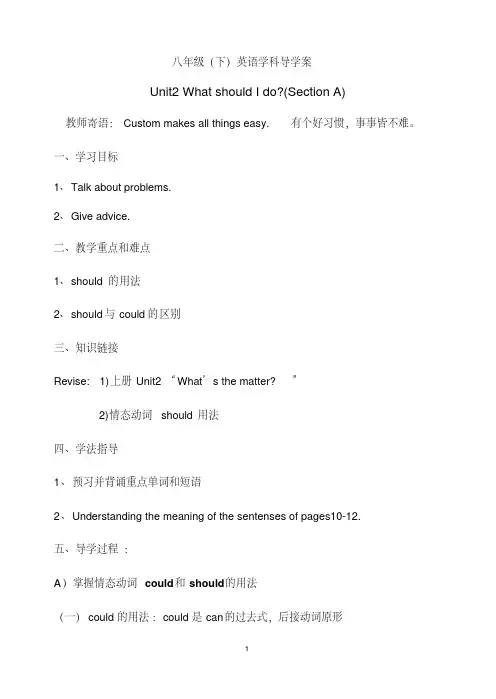
八年级(下)英语学科导学案Unit2 What should I do?(Section A)教师寄语:Custom makes all things easy.有个好习惯,事事皆不难。
一、学习目标1、Talk about problems.2、Give advice.二、教学重点和难点1、should 的用法2、should与could的区别三、知识链接Revise: 1)上册Unit2 “What’s the matter?”2)情态动词should用法四、学法指导1、预习并背诵重点单词和短语2、Understanding the meaning of the sentenses of pages10-12.五、导学过程:A)掌握情态动词could和should的用法(一)could的用法:could是can的过去式,后接动词原形1、表示过去的能力。
如I could jump higher when I was young.2、表推测、可能性,意为“可能”。
如:----Will you answer the phone?-----It could be your mother . 3、表示委婉地提出请求、给出建议。
如:Could I use your umbrella? (二)should 的用法:后接动词原形,否定式为shouldn’t.1、表义务、忠告,用于委婉的提出建议、给予劝告,意为“应该”。
如:You should see a doctor at once .2、表要求、命令。
如: You should listen to the teachers carefully.3、也表示一种推测、推论。
意为“应当,应该”。
如:He should be at home now .4、用于第一人称的疑问句中,用来询问对方意愿、征求对方意见。
如:Should I open the window ?(三)句型:You should ask her first .变否定句:__________________________________划线提问:_____ _____ I _____ ?(四)Discuss and give advice :1、----My clothes are out of style . What should I do?----Maybe you _______ ________some new clothes .2、----I lost my backpack. What_______I do?----You______go to the lost and found .3、----I want to practice my Putonghua .What should I ______?----You should_______a tutor .4、--- My sister plays her CDs too loud .What should I_____?--- You_______ask her to______it_______.5、----I need some money to buy a computer .What______I _____?----I think you should ______a part-time job.B)aloud ,loud ,loudly 的区别:aloud 只做副词,意为_______________,含又能够被听见之意.如:Please read the story aloud.loud既可作形容词,又可作副词,主要指说话声或笑声,在口语中代替loudly。
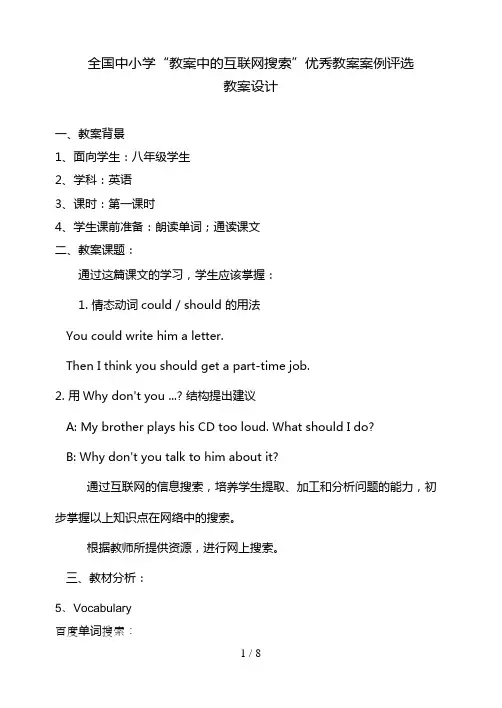
全国中小学“教案中的互联网搜索”优秀教案案例评选教案设计一、教案背景1、面向学生:八年级学生2、学科:英语3、课时:第一课时4、学生课前准备:朗读单词;通读课文二、教案课题:通过这篇课文的学习,学生应该掌握:1. 情态动词could / should 的用法You could write him a letter.Then I think you should get a part-time job.2. 用Why don't you ...? 结构提出建议A: My brother plays his CD too loud. What should I do?B: Why don't you talk to him about it?通过互联网的信息搜索,培养学生提取、加工和分析问题的能力,初步掌握以上知识点在网络中的搜索。
根据教师所提供资源,进行网上搜索。
三、教材分析:5、Vocabulary百度单词搜索:argue, loud, original ,out of style, tutor, upset, adult,Recycling: problem, sorry, part-time, important, friend, money, home, new, easy, letter, ticket, ball game, surprise, colorful, borrow, write, call someone up, go to someone’s house, every nightB. Target languageMy brother plays his CD too loud.What should I do ?Why don’t y ou talk to him about it?C. StructuresModals could, shouldWhy don’t you …?教案方法:视听教案法,小组讨论法教案过程:I. Teaching aims and demands:Students learn to talk about problems and give advice.II. Teaching key and difficult points:A. Vocabularykeep out , play, loud, argue, wrong, What’s wrong ? out of style , could, should,B. Target languageMy brother plays his CDs too loud.Maybe you should buy some new clothes.III. Teaching methods: Audio-lingual methodsIV. Teaching aids: a tape recorderV. Teaching procedureActivity 1. RevisionTask 1. DictationTask 2. Ask and answer.Questions about future with will.Activity 2. PresentationThis activity introduces some new vocabulary.Task 1 . Make a two-column chart on the board with the heading Problem at the top of column 1 and the heading Advice at the top of column 2 .Then ask the students to tell you what you could do about it.Task 2. Then read the problem to the class again. Then write the words could ,should ,and shouldn’t on the board next to the chart. Read the problem to the class again and help the class give advice using the words could, sh ould ,and shouldn’t.Task 3. Ask the students to finish the task in 1a.Teach : Serious problem is a very bad problem, a very big problem. Out of style means not in fashion.enough money : I don’t have enough money to buy a bike.Ask the students to write the problems in the serious or Not serious column. Task 4. Talk about the answers.Ask ,Who put “My parents want me to stay at home every night?” the serious column? Ask the same questions about the other items. Discuss which problems students thought were the most serious.Activity3. Listen and circle the problems you hear in activity 1a.Task 1.Point to the pictures in activity 1a. Ask different students to say what they see in each picture. Read the instructions to students.Task 2. Play the recording the first time. Students only listen.Task 3. Play the recording a second time. Students circle the problems they hear. Then check the answers.Step4. PairworkAsk the students to look at the problems in activity 1a and make conversations.Homework1. Make up your own conversations.2. Make ten sentences with could, should and shouldn’t.作文拓展:六、教案反思在教案过程中,我采用了小组合作的方式,要求学生会用英语在生活中遇到的各种各样的麻烦和问题,并且相互找到合理的解决办法及建议,在课堂教案中学会使用句型What should I do ?从学生的实际出发。
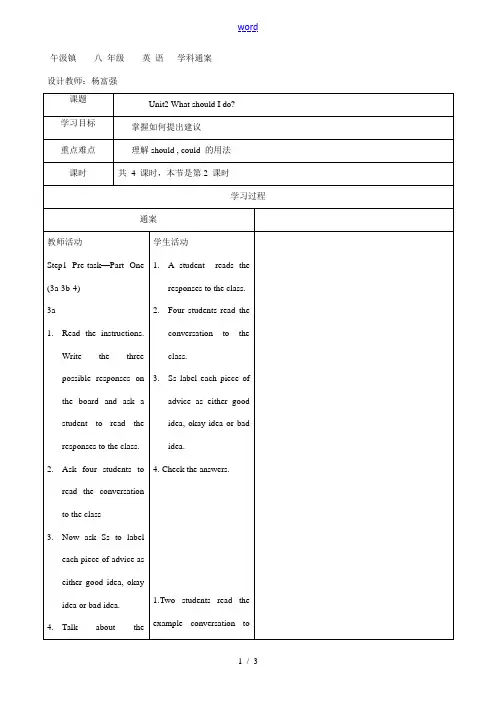
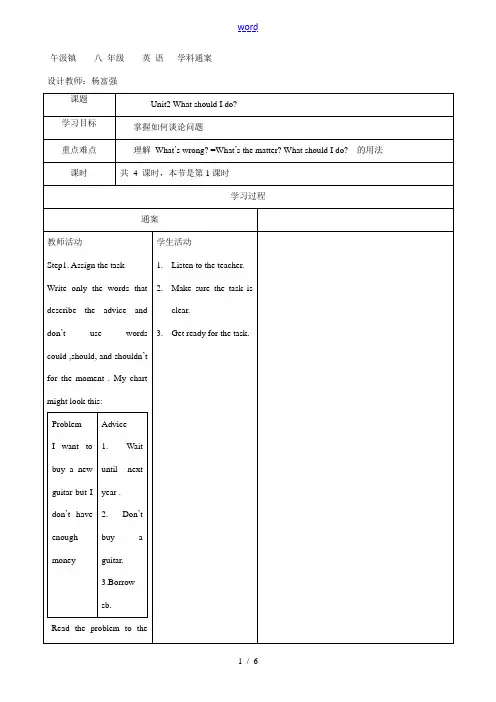
八年级英语U n i t W h a t s h o u l d I d o教案Document number【980KGB-6898YT-769T8CB-246UT-Unit 2 What should I doI. Teaching aims and teaching demands:In this unit students learn to talk about problems and give advice.II. Teaching key and difficult points:A.Vocabularyargue, loud, original ,out of style, tutor, upset, adult, Recycling: problem, sorry, part-time, important, friend, money, home, new, easy, letter, ticket, ball game, surprise, colorful, borrow, w rite, call someone up, go to someone’s house, every night B. Target languageMy brother plays his CD too loud.What should I doWhy don’t you talk to him about itC.StructuresModals could, shouldWhy don’t you …(formulaic)III. Teaching methods: Audio-lingual methodsIV. Teaching aids: a tape recorderV. This unit is divided into seven periods.Lesson 1 Speak and listenSection A 1a---1cI. Teaching aims and demands:Students learn to talk about problems and give advice.II. Teaching key and difficult points:A.Vocabularykeep out , play, loud, argue, wrong, What’s wrong out of style , could, should,B.Target languageMy brother plays his CDs too loud.Maybe you should buy some new clothes.III. Teaching methods: Audio-lingual methodsIV. Teaching aids: a tape recorderV. Teaching procedureActivity 1. RevisionTask 1. DictationTask 2. Ask and answer.Questions about future with will.Activity 2. PresentationThis activity introduces some new vocabulary.Task 1 . Make a two-column chart on the board with the heading Problem at the top of column 1 and the heading Advice at the top of column 2 .Then ask the students to tell you what you could do about it.Task 2. Then read the problem to the class again. Then write the words could ,should ,and shouldn’t on the board next to the chart. Read the problem to the class again and help the class give advice using the words could, should ,and shouldn’t.Task 3. Ask the students to finish the task in 1a.Teach : Serious problem is a very bad problem, a very big problem. Out of style means not in fashion.enough money : I don’t have enough money to buy a bike.Ask the students to write the problems in the serious or Not serious column.Task 4. Talk about the answers.Ask ,Who put “My parents want me to stay at home every night” the serious column Ask the same questions about the other items. Discuss which problems students thought were the most serious. Activity3. Listen and circle the problems you hear in activity 1a. Task to the pictures in activity 1a. Ask different students to say what they see in each picture. Read the instructions to students. Task 2. Play the recording the first time. Students only listen.Task 3. Play the recording a second time. Students circle the problems they hear. Then check the answers.Step4. PairworkAsk the students to look at the problems in activity 1a and make conversations.Homework1.Make up your own conversations.2. Make ten sentences with could, should and shouldn’t.Lesson 2 Listen and speakSection A 2a---Grammar FocusI. Teaching aims and demands :Students learn to talk about problems and give advice.II. Teaching key and difficult points:A.Vocabularycall sb. up, ticket, surprise, on the phone, What’s the matter B.Target languageYou could go to his house.You could give him a ticket to a ball game.What should I /he/they doIII. Teaching methods: Audio-lingual methods and PPPIV. Teaching aids: a tape recorderprocedureActivity 1. RevisionTask1. Check the homework. Ask and answer.Task2. Revise the vocabulary.Activity 2. Listening and circling .the instructions. Learn the key vocabulary.Read and repeat the phrases.will hear a conversation between Nari and a friend.Play the recording twice and students circle the word ,Nari’s friend uses to give advice.Then check the answers.ActivityTask 1. Read the instructions. Show students the example match.Task 2. Play the recording again and check the answers.Activity 4. GroupworkTask the instructions for the activity.Task 2. Point to the example in the sample dialogue. Ask two students to read the conversation to class.Task 3. Ask students to role play a conversation between Nari and his friend using these two sets of have the students work in pairs. Task 4. Check the answers by calling on different pairs to say a conversation to the class.Activity 5. Grammar FocusReview the grammar the students to say the questions and the responses. Explain that the word should is always used to ask foradvice, but the words could, should, and shouldn’t are used to give advice. Could is a less serious word than should.Pay attention to the questions and answers, ask and answer loudly. Homework1.Review the conversation and the vocabulary.2.Write your own conversations on giving advice.Lesson 3 Reading and writingI. Teaching aims and demands :Students learn to talk about problems and give advice.II. Teaching key and difficult points:A. Vocabularypay for, part-time job, okay, either, bake, Teen Talk, tutor, need, maybe, good idea, bad idea, okay ideaB. Target languageWhat should I doThen I think you should get a part- time job.III. Teaching methods: Audio-lingual methods and Control-reading and writing.IV. Teaching aids: a pictureprocedureActivity 1. RevisionTask the vocabulary and the key structures.Task .Activity 2. Reading and writingTask 1 .Read the instructions. Write the possible responses on the Bb and ask a student to read the responses to the class. Discuss the three responses and be sure students understand how the responses are used.Task 2. Ask four students to read the conversation to the class. Ask the students to fill in the blank.Then ask and answer in groups.Activity 3. PairworkTask 1. Read the then ask two students to read the sample conversation.the students to say some ways to get money that aren’t in the book.Task 3. ask the students to work with partners as they ask for and give ask two or three pairs of the students to say their conversations to the class.Activity 4. PairworkThis activity provides an opportunity for students to use the language of the unit to give advice.Task 1. Read the instructions. Then ask two students to read the dialogue.Task 2. Ask another pair of students to give their advice on another topic. Pick a topic of current interest in the news.Homeworkthe vocabulary and target language.your own conversations about problems and advice.Lesson 4 Section BI. Teaching aims and demands :Students practice using the target language.II. Teaching key and difficult points:A. Vocabularyoriginal , the same as, in style, nicer, haircut, inexpensive, comfortableB. Target languageI think Erin should tell her friend to get different clothes. Friends shouldn’t wear the same clothes.They are the same as my friend’s clothes.III. Teaching methods: Audio-lingual methodsIV. Teaching aids: a tape recorderV. Teaching procedureActivity 1. RevisionThis activity introduces the key vocabulary.Task the instructions in 1a. Ask a student to read the sentences to the each sentence again and ask the Ss to repeat it. Then explain in their own words that each sentence means.For example: T: What does original meanS1: Different from others. Not the same.T: Correct. When something is original, it is not like all the others. Can you give an exampleS1:My watch doesn’t have numbers on it. It haspictures of faces instead of numbers. My watch isoriginal.T: Correct. It’s not like all the others.Task out the write-in line in front of each sentence. write VI if the statement is very important to you, write I if the statement is somewhat important to you, and write NI if it is not important. Task 3. Talk about the answers with the class.Activity 2. ListeningTask 1. Read the instructions.Point to the three items students will be listening for:Say you will be listening to a radio advice program. People call in for help with a problem and other people call up with advice. They will be talking about one of these problems. Please check the problem they talk about.Task 2. Play the recording the first time. Students only listen. Task 3. Play the recording a second the students to put a check in front of these problems. Then check the answer.Activity and writingA.Listen carefully and fill in the chart with the advice that youhear .Then check the answers .B.Listen again and fill in the chart. Then check the answers. Activity 4. PairworkTask the instructions.Task two students to read the conversation to the class.Task 3. Work with the partners and say what do you think Erin should do.Ask some pairs of students to say part of their conversation to the class.Homeworkthe vocabulary .your own conversations about advice.Lesson 5 Reading and writingaims and demands :Students practice the target language by reading and writing.II. Teaching key and difficult points:except, upset, find out, do wrong, what to do, lonely, arguelanguageWhat should I doYou could be more friendly.You should try to be funny.Everyone else in my class was invited except me.I’m very upset and don’t know what to do.I just found out that my friends were planning a birthday party for my best friend,…III. Teaching methods: Audio-lingual methods and Control-writing. IV. Teaching aids: a tape recorderprocedureStep 1. RevisionTask1. Check the homework. Ask and answer.the vocabulary.Step 2. Reading and writingTask these words:except: Everyone has a bike except Jim.Everyone has a bike besides Jim.find out: learn, Please find out where they live.I can’t think what I did wrong.I don’t know what to do.Task 2. Ask the students to read the instructions.Task 3. Ask the students to read the letter and underline the problem on their own.Correct the answers.Step 3. WritingTask 1. Read the instructions.Ask a student to say some of the advice they might give. Write the key words on the board.Task 2. Ask the students to write the letters on their own.Task 3. Ask some students to read their letters to the class.Step 4. Writing on your own.1.read the instructions.2.ask the students to say some problems they might write about.3.ask some students to read their letters.Step 5. Groupwork1.Ask the students to read the instructions.2.Ask two students to read the dialogue.3.Ask another pair of students to give their advice for one of theproblems.4.Ask students to complete the work in groups.5.Ask a few students to share the sample conversations.Step Check1.Ask the students to do the exercises on their own .Then checkthe answers.2.Read the letter and then write some advice.3.Ask a few students to read their letters of advice.4.Just for fun. Ask two students to read the conversation to theclass.Homeworkthe vocabulary .off the writing exercises.Lesson 6 Reading and writingI. Teaching aims and demands :Students learn to master the reading skills.key and difficult points:A. Vocabularyuntil, fit, as much as possible, pressure, complain, include, pushy, send, all kinds of, compare, crazy, adult, on the onehand, …organized, on the other hand,…B. Target languageWhat should you do to relaxParents should learn to give their kids a bit more time to themselves.III. Teaching methods: Audio-lingual methods and Control-readingand writing.IV. Teaching aids: a tape-playerprocedureActivity 1. RevisionTask the vocabulary and the key structures.Task .Activity 2. Before You ReadTask 1 .Read the instructions.1.Encourage the students to think about life outside school hours.List them on the Bb.2.Ask the students to use the list on the Bb to complete the twoboxes labeled ‘I do’, and ‘I don’t do-‘. They are free to add any ore activities they do, or don’t currently.3.Ask a few students to share what they have written.Task the students about using a dictionary.1.Explain that a dictionary can help students learn can learn newwords, how to pronounce them, and how to use them correctly.2.Let the students to look up the words in the box.3.Have a brief memory quiz on all the words.4. Discuss the points made in the Reading Strategy about using a bilingual ,learner’s and electronic dictionary.Activity 3. While You ReadingTask 1. Ask the students to read and notice the words they havejust looked up in their dictionaries. Read the sentences to the class.the students to read the passage loudly .Homeworkthe vocabulary and target language.your own conversations about problems and advice.Lesson 7 Reading and writeI. Teaching aims and demands :Students learn to master the reading skills.key and difficult points:A. Vocabularyuntil, fit, as much as possible, pressure, complain, include, pushy, send, all kinds of, compare, crazy, adult, on the onehand, …organized, on the other hand,…B. Target languageWhat should you do to relaxParents should learn to give their kids a bit more time to themselves.III. Teaching methods: Audio-lingual methods and Control-readingand writing.IV. Teaching aids: a tape-playerV. Teaching procedureActivity 1. RevisionTask 1. Dictation.Task 2. Read the passage to the class.Activity 2. After You ReadTask 1. Read the statements.Task 2. Discuss with your partners.Task 3. Ask each group to report their ideas to the class.Activity 3. writingAsk the students to write a sentence of their own using the words from the box in Section1b.Activity 4. WritingTask the instructions.Task language used for imagine you are Dr Alice a letter to Cathy Taylor. Give advice about what she should do with her children.Activity 5. Go for it !1.Write Pressure on the a survey with two questions:When do you feel under pressureWhat should you do to relaxthere is someone in your class who has a big problem, make a plan to help them.Homeworkthe vocabulary .writing the letter.。